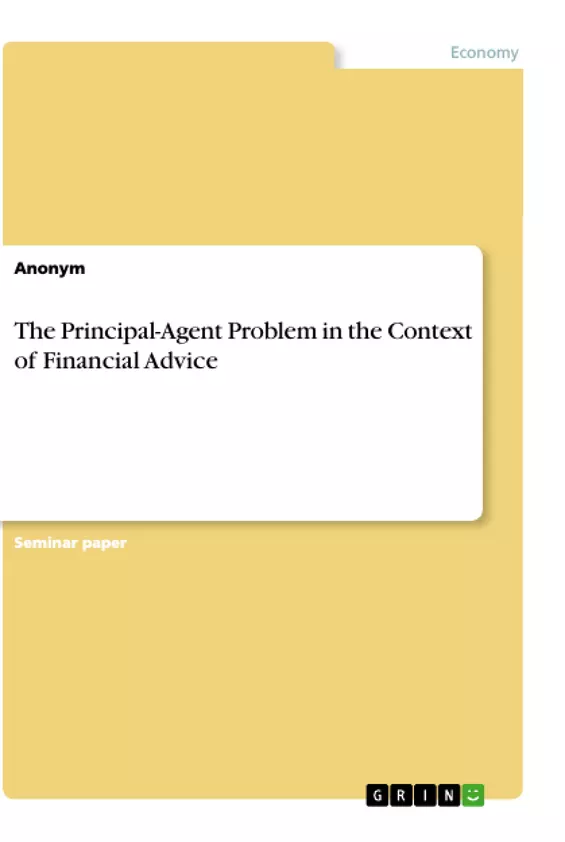This paper studies the relationship between investors and investment advisers with regard to the principal-agent theory. Especially, the payment of commissions, kick-backs or other inducements from product provider to financial adviser and their impact of product recommendations are the focus of this paper. At the end, this paper should answer the research question, to what extent is the investor-investment adviser relationship a principal-agent relationship and how do commission payments affect the decision of both participants. Furthermore, this paper contents the political aspect, especially the analysis of the latest German policy with regard to consumer protection in financial markets.
This paper is divided in six chapters. Chapter 2 is a definition and classification of various types of financial advisers. In chapter 3, this work elaborates the principal-agent theory and compare it to our case of financial advice. In chapter 4, we set up a model of the interdependence between product provider, adviser and customer. In addition, this model gives information about payments and related incentives. The following 5th chapter, analyzes the latest policy intervention of the European Union with regard to the German financial advice market. The last chapter is a conclusion of the previous chapters.
Inhaltsverzeichnis (Table of Contents)
- Introduction
- Different Types of Financial Advisors
- Principal-Agent Theory
- Asymmetric Information
- Adverse Selection and Possible Solutions
- Principal-Agent Theory in Financial Advice
- Modelling Financial Advice
- Implications of MiFID II and Criticism
Zielsetzung und Themenschwerpunkte (Objectives and Key Themes)
This paper investigates the relationship between investors and investment advisors, particularly in light of the principal-agent theory. The focus is on commission payments, kickbacks, and other inducements from product providers to financial advisors, and their impact on product recommendations. The research question explored is to what extent the investor-investment advisor relationship is a principal-agent relationship and how commission payments affect the decision-making of both participants.
- The impact of principal-agent theory in financial advice
- The role of commission payments in investment decisions
- The influence of product providers on financial advisor recommendations
- Consumer protection in financial markets
- The evolution of financial advice and its implications for investors
Zusammenfassung der Kapitel (Chapter Summaries)
- Introduction: The introduction sets the scene by discussing the concept of the "Lehman Oma" and the consequences of selling complex financial products to unsophisticated investors. It highlights the issue of potential conflict of interest between financial advisors and investors due to commission structures.
- Different Types of Financial Advisors: This chapter analyzes the various types of financial advisors, categorizing them based on their payment structure and fiduciary duties. It explores the difference between the suitability standard and the fiduciary standard, which governs the advisors' responsibilities to their clients.
- Principal-Agent Theory: This chapter delves into the principal-agent theory, a framework that helps understand the relationship between two parties where one acts on behalf of the other. The chapter applies this theory to the context of financial advice, exploring how information asymmetry and potential conflicts of interest can arise.
- Modelling Financial Advice: This chapter develops a model to illustrate the interdependence between product providers, financial advisors, and investors. The model incorporates payments and incentives related to financial advice.
- Implications of MiFID II and Criticism: This chapter examines the latest European Union policy intervention in the German financial advice market, focusing on the implications of MiFID II and its critiques.
Schlüsselwörter (Keywords)
The core keywords and focus topics of this paper include principal-agent theory, financial advice, commission payments, kickbacks, product provider influence, consumer protection, MiFID II, asymmetric information, adverse selection, investor behavior, and fiduciary duty.
- Quote paper
- Anonym (Author), 2018, The Principal-Agent Problem in the Context of Financial Advice, Munich, GRIN Verlag, https://www.grin.com/document/1022270



